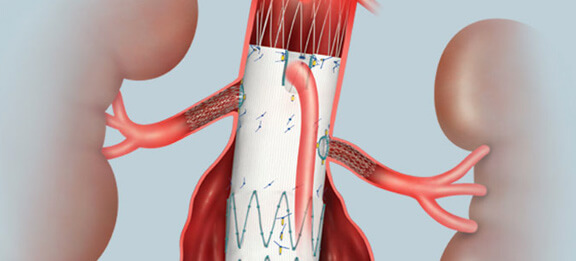Case Study 1:
Revision Surgery for Thoracic and Abdominal Aortic Aneurysm Using a Minimally Invasive Endovascular Fenestrated Stent Graft
An 81-year old female patient (Jehovah’s Witness) presented with an expanding aortic aneurysm in the thoraco-abdominal (chest and abdomen) region that had enlarged from 5 to 7 centimeters.
The patient’s prior endovascular aortic aneurysm stent graft repair in the infra-renal portion of the abdominal aorta made the current aneurysm repair substantially more challenging. Since she is a Jehovah’s Witness and does not accept blood transfusions, it was decided that an open surgical approach was not an option due to the high risk of bleeding. A minimally invasive, endovascular repair was chosen as the ideal treatment method since the expected blood loss is decreased dramatically compared to traditional open aortic surgery.
The surgery was performed by one of our most experienced vascular surgeons, Dr. James Black, and took place over the course of 7 hours. The anesthesia care was provided by Dr. Steven Frank, the Director of the Center for Bloodless Medicine and Surgery at Johns Hopkins. The spinal drain performed nicely and the patient’s blood pressure was maintained above the threshold necessary to ensure blood flow to the kidneys and the spinal cord. Total blood loss was 300 ml (about 6% of total blood volume). The majority of the blood lost was returned to the patient using autologous blood salvage (Cell Saver). This option had been discussed with the patient, and she agreed to its use. She awoke from the surgery with normal movement in both arms and both legs.

The patient’s preoperative hemoglobin was 11.3 and the postoperative hemoglobin was 9.6, well within the margin of safety. Her postoperative course included 5 days of erythropoietin, intravenous iron, B12, and folate, a regimen recommended by our Bloodless team Hematology consultant, Dr. Linda Resar, in order to stimulate the bone marrow to produce red blood cells. After a few days of physical therapy, she was able to walk on her own and she was discharged from the hospital after an 8-day stay. Since discharge, she has not experienced any further problems, and has not needed to return.
